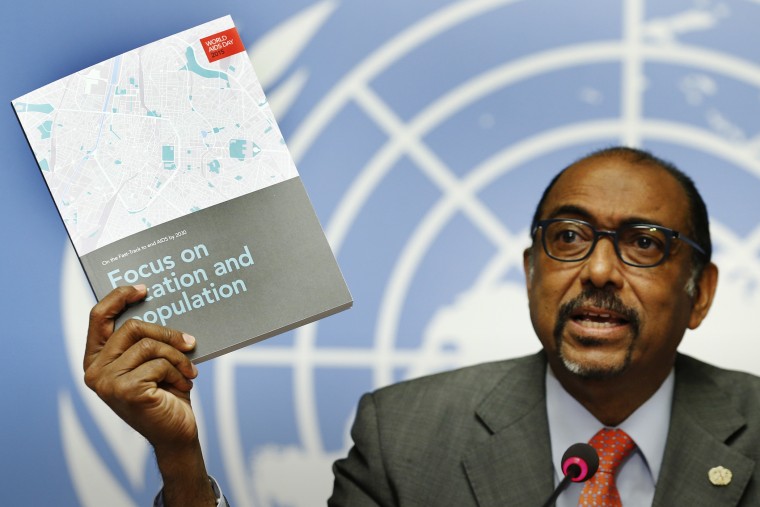Ending AIDS won’t be easy or cheap, but we can do it if we choose to.
In September, world leaders committed to ending the AIDS epidemic by 2030 as part of the United Nations' Sustainable Development Goals. Such ambition was implausible just a few years ago, when infection with HIV was synonymous with a death sentence. Today, it doesn’t have to be – for those lucky enough to have access to treatment and services. With access to medicine, people living with HIV can live long, productive and fruitful lives. We have the knowledge and the means to treat all who need it, but we must invest more now to end AIDS by 2030.
The good news is that, by the end of this year, close to 16 million people will have access to treatment. As UNAIDS Executive Director Michel Sidibé said in a statement, “Every five years we have more than doubled the number of people on life-saving treatment. We need to do it just one more time to break the AIDS epidemic and keep it from rebounding.” At the end of 2014, new HIV infections had fallen by 35% since the peak in 2000 and AIDS-related deaths by 42% since the 2004 peak. Lower diagnostic and treatment costs mean that investments in health care now stretch further.
RELATED: Ending AIDS, changing the world — and how you can help
But we cannot be complacent. AIDS is not over. The progress is unfinished, fragile and reversible. By the end of 2014, there were almost 37 million people living with HIV, and more than 2 million people were newly infected. The latest World Health Organization guidelines say that all people diagnosed with HIV should have immediate access to treatment. Right now, 21 million people are going without the treatment they need – a death sentence that still claims more than 1 million lives each year.
If we continue to accelerate progress as we have over the last five years, we will break – once and for all – the trajectory of this disease. We must fast-track prevention, treatment, care and support to the millions of people who still need it. If we focus on locations and populations with the greatest need, we can avert 21 million AIDS-related deaths, 28 million new HIV infections and 5.9 million new infections among children. Last week, in the run-up to World AIDS Day, UNAIDS launched a report that details the progress made but that also makes a strong case to front-load investments in tackling HIV and AIDS if we are really to condemn this disease to the archives.
Spending more money now saves money later and it saves lives today. The front-loading of investments needs to increase substantially from an annual figure of $22 billion in 2014 to $31 billion by 2020. We live in an interconnected and inter-related world. We won’t end AIDS if we don’t also address, among other things, poverty, inequality, jobs and growth, violence against women, and peace and security. And we won’t achieve any of this with the same old thinking and approaches. The sustainable development goals recognize this and call for nothing short of a transformed world, acknowledging that progress across all the goals is in everyone’s best interest, whoever and wherever they are.
RELATED: UN: AIDS can be stopped by 2030, but stigma remains a barrier
It is too easy to say there isn’t enough money to go around, but it is simply not true. It is the way this money is used and channelled that will determine success or failure. We must change our perceptions and attitudes from looking at this as North-South, donor-recipient or charitable relationship to one of mutual dependence. You might think Africa is heavily dependent on charity, but its domestic resources dwarf international aid at over $500 billion in 2012 by a factor of 10:1, and economic growth continues to outpace more developed markets.
We need to transform global finance. Good profit and shared-value creation can unlock billions of private-sector dollars; broadened and strengthened taxation systems and financial inclusion will raise billions more. Aid, philanthropy and charity will play an important role, but unlocking investment capital in ways that generate both a financial return and a social benefit will provide the transformative change we need.
An annual income of just $34,000 puts you in the richest 1% of the world. Just $1,225 places you in the top half. America's poorest are some of the world's richest. This year, World AIDS Day also coincides with #GivingTuesday. So if you are lucky enough to be investing and saving, ask not only what is the risk and the likely return, ask also, “Will this investment do good and help make the world a better place?” If we channel resources from all sources in new ways, the task ahead is not only feasible; it also makes good sense for everyone and will help end AIDS.
Simon Bland, CBE, is the director of the UNAIDS New York Office. He is the former chairman of the board of directors of the Global Fund to Fight AIDS, TB, and Malaria. In 2013, Bland was made a commander of the British Empire in the Queen’s Birthday Honours list for his service to global health.
